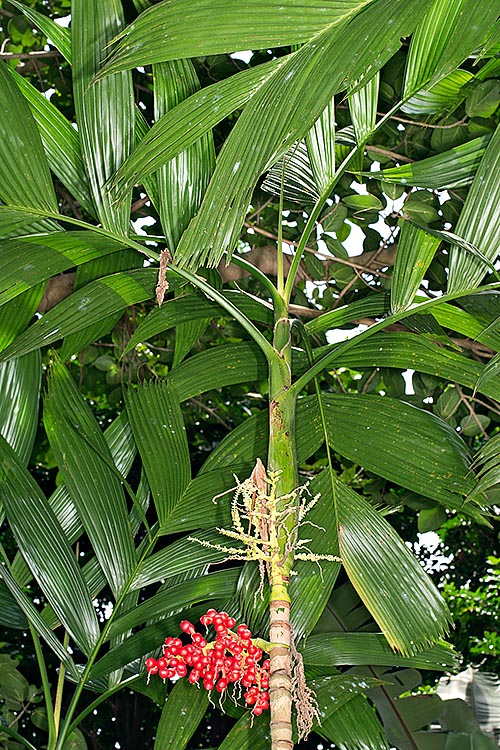Family : Arecaceae

Text © Pietro Puccio

English translation by Mario Beltramini

Areca novohibernica grows in Bismarck and Solomon islands pluvial forests © G. Mazza
The species is native to the Bismarck Archipelago and the Solomon Islands where it grows in the pluvial forests.
The name of the genus is the Latinization of the local name of an Indian species belonging to the genus; the name of the species refers to the origin place of the first specimen described, the island of Nova Hibernia (New Ireland) in the Bismarck Archipelago.
Areca novohibernica (Lauterb.) Becc. (1914) is an unarmed monoecious species with thin single stem, 3-6 cm of diameter, erect, 2-4 m tall, on which are visible the rings, spaced of 3-4 cm, trace of the attachment of the fallen leaves; it has at the base robust aerial roots which develop like stilts.
The leaves, on an up to about 40 cm long petiole, are pinnate, arcuate, 1,2-1,9 m long, with the foliar base wrapping totally the trunk for a height of about 40 cm forming a sort of a tubular capital with a slight swelling in the lower part. The pinnules, of variable breadth, 4-15 cm, with numerous pleats and indented at the extremity, are 40-70 cm long, of glossy intense green colour.
The about 30 cm long ramified inflorescences are under the leaves, on a 4 cm long peduncle, initially enclosed in a deciduous membranaceous spathe, carrying unisexual flowers of both sexes, with the female ones arranged at the base of the branches. Ovate-elliptic fruits, 3-3,5 cm long and of about 1,8 cm of diameter, red when ripe, containing one only seed, 1,4-1,9 cm long and 1,3 cm broad. It reproduces by seed in organic sandy loam at the temperature of 24-26 °C.
Areca novohibernica is inserted in the category NT, Near Threatened of the Red List of the International Union for Conservation of Nature (IUCN).
Little diffused species with very elegant habit, to be utilized isolated or in groups at the shade of great trees exclusively in the tropical and humid subtropical climate zones, on soils rich of organic substance, draining, and constantly kept humid; suitable for its contained dimensions also to small shadowy gardens.
Young specimens in pot can be employed for the decoration of inner spaces, greenhouses and winter gardens in luminous position, but avoiding the direct sun, utilizing substrata rich of humus with addition of coarse sand, agri-perlite or other inert around the 30%, for improving the drainage; the waterings must be regular during the whole year and the temperatures it is good that they do not fall under the +16 °C.
Synonyms: Nenga novohibernica Lauterb. (1911).
→ For general notions about ARECACEAE please click here.
